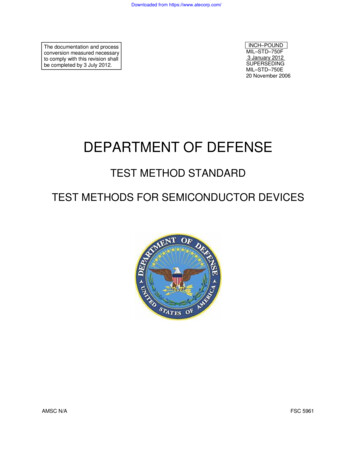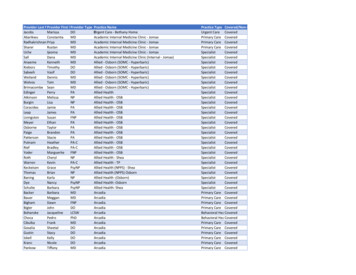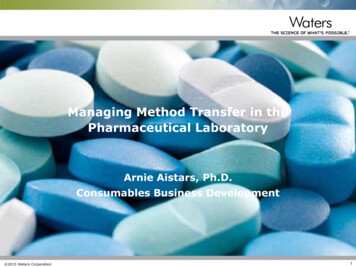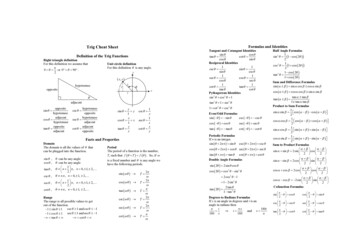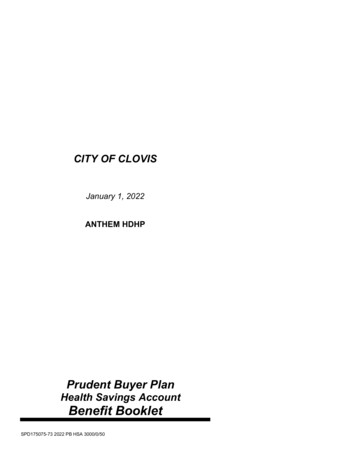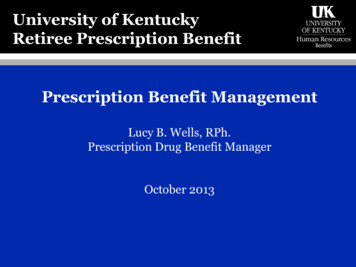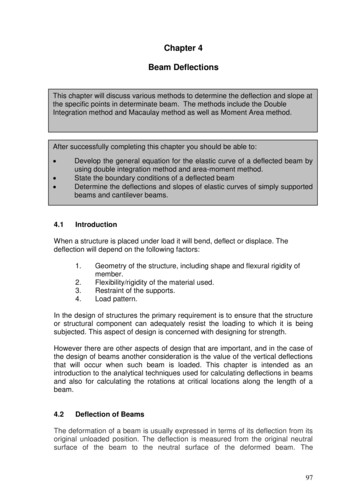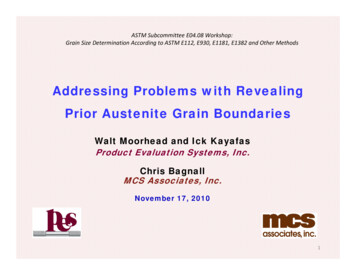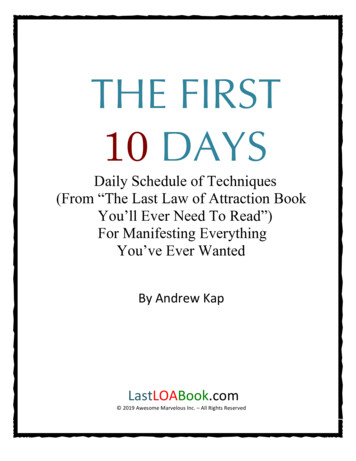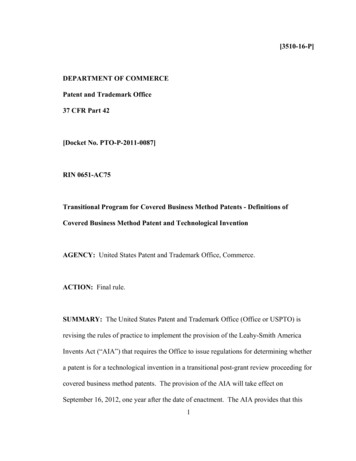
Transcription
[3510-16-P]DEPARTMENT OF COMMERCEPatent and Trademark Office37 CFR Part 42[Docket No. PTO-P-2011-0087]RIN 0651-AC75Transitional Program for Covered Business Method Patents - Definitions ofCovered Business Method Patent and Technological InventionAGENCY: United States Patent and Trademark Office, Commerce.ACTION: Final rule.SUMMARY: The United States Patent and Trademark Office (Office or USPTO) isrevising the rules of practice to implement the provision of the Leahy-Smith AmericaInvents Act (“AIA”) that requires the Office to issue regulations for determining whethera patent is for a technological invention in a transitional post-grant review proceeding forcovered business method patents. The provision of the AIA will take effect onSeptember 16, 2012, one year after the date of enactment. The AIA provides that this1
provision and any regulations issued under the provision will be repealed on September16, 2020, with respect to any new petitions under the transitional program.DATES: Effective Date: The changes in this final rule take effect on September 16,2012.Applicability Date: The changes in this final rule apply to any covered business methodpatent issued before, on, or after September 16, 2012.FOR FURTHER INFORMATION CONTACT: Sally C. Medley, AdministrativePatent Judge; Michael P. Tierney, Lead Administrative Patent Judge; Robert A. Clarke,Administrative Patent Judge; and Joni Y. Chang, Administrative Patent Judge; Board ofPatent Appeals and Interferences, by telephone at (571) 272-9797.SUPPLEMENTARY INFORMATION:Executive Summary: Purpose: On September 16, 2011, the AIA was enacted into law(Pub. L. 112-29, 125 Stat. 284 (2011)). The purpose of the AIA and this final rule is toestablish a more efficient and streamlined patent system that will improve patent qualityand limit unnecessary and counterproductive litigation costs. The preamble of this noticesets forth in detail the definitions of the terms “covered business method patent” and“technological invention” that the Board will use in conducting transitional coveredbusiness method patent review proceedings. The USPTO is engaged in a transparentprocess to create a timely, cost-effective alternative to litigation. Moreover, this2
rulemaking process is designed to ensure the integrity of the trial procedures. See35 U.S.C. 326(b).Summary of Major Provisions: This final rule sets forth the definitions of the terms“covered business method patent” and “technological invention” that the Office will usein conducting transitional covered business method patent review proceedings.Costs and Benefits: This rulemaking is not economically significant, but is significant,under Executive Order 12866 (Sept. 30, 1993), as amended by Executive Order 13258(Feb. 26, 2002) and Executive Order 13422 (Jan. 18, 2007).Background: To implement sections 6 and 18 of the AIA, the Office published thefollowing notices of proposed rulemaking: (1) Rules of Practice for Trials before thePatent Trial and Appeal Board and Judicial Review of Patent Trial and Appeal BoardDecisions, 77 FR 6879 (Feb. 9, 2012), to provide a consolidated set of rules relating toBoard trial practice for inter partes review, post-grant review, derivation proceedings, andthe transitional program for covered business method patents, and judicial review ofBoard decisions by adding new parts 42 and 90 including a new subpart A to title 37 ofthe Code of Federal Regulations (RIN 0651-AC70); (2) Changes to Implement InterPartes Review Proceedings, 77 FR 7041 (Feb. 10, 2012), to provide rules specific to interpartes review by adding a new subpart B to 37 CFR part 42 (RIN 0651-AC71);(3) Changes to Implement Post-Grant Review Proceedings, 77 FR 7060 (Feb. 10, 2012),to provide rules specific to post-grant review by adding a new subpart C to 37 CFR part3
42 (RIN 0651-AC72); (4) Changes to Implement Transitional Program for CoveredBusiness Method Patents, 77 FR 7080 (Feb. 10, 2012), to provide rules specific to thetransitional program for covered business method patents by adding a new subpart D to37 CFR part 42 (RIN 0651-AC73); (5) Transitional Program for Covered BusinessMethod Patents—Definition of Technological Invention, 77 FR 7095 (Feb. 10, 2012), toadd a new rule that sets forth the definition of technological invention for determiningwhether a patent is for a technological invention for purposes of the transitional programfor covered business method patents (RIN 0651-AC75); and (6) Changes to ImplementDerivation Proceedings, 77 FR 7028 (Feb. 10, 2012), to provide rules specific toderivation proceedings by adding a new subpart E to 37 CFR part 42 (RIN 0651-AC74).Additionally, the Office published a Patent Trial Practice Guide for the proposed rules inthe Federal Register to provide the public an opportunity to comment. Practice Guide forProposed Trial Rules, 77 FR 6868 (Feb. 9, 2012) (Request for Comments) (hereafter“Practice Guide” or “Office Patent Trial Practice Guide”). The Office envisionspublishing a revised Patent Trial Practice Guide for the final rules. The Office alsohosted a series of public educational roadshows, across the country, regarding theproposed rules for the implementation of the AIA.In response to the notices of proposed rulemaking and the Practice Guide notice, theOffice received 251 submissions offering written comments from intellectual propertyorganizations, businesses, law firms, patent practitioners, and others, including a UnitedStated senator who was a principal author of section 18 of the AIA. The comments4
provided support for, opposition to, and diverse recommendations on the proposed rules.The Office appreciates the thoughtful comments, and has considered and analyzed thecomments thoroughly. The Office’s responses to the comments are provided in the 124separate responses based on the topics raised in the 251 comments in the Response toComments section infra.Section 18 of the AIA provides that the Director may institute a transitional proceedingonly for a patent that is a covered business method patent. In particular, section 18(d)(1)of the AIA specifies that a covered business method patent is a patent that claims amethod or corresponding apparatus for performing data processing or other operationsused in the practice, administration, or management of a financial product or service,except that the term does not include patents for technological inventions.Section 18(d)(2) of the AIA provides that the Director will issue regulations fordetermining whether a patent is for a technological invention. Consistent with thesestatutory provisions, this rulemaking provides regulations for determining whether apatent is for a technological invention. The AIA provides that the transitional programfor the review of covered business method patents will take effect onSeptember 16, 2012, one year after the date of enactment, and applies to any coveredbusiness method patent issued before, on, or after September 16, 2012. Section 18 of theAIA and the regulations issued under this provision will be repealed on September 16,2020. Section 18 of the AIA and the regulations issued will continue to apply afterSeptember 16, 2020, to any petition for a transitional proceeding that is filed beforeSeptember 16, 2020.5
Pursuant to section 18(d) of the AIA, the Office is prescribing regulations to set forth thedefinitions of the terms “covered business method patent” and “technological invention”in its regulation. In February 2012, the Office published two notices proposing changesto 37 CFR chapter I to implement sections 18(d)(1) and (d)(2) of the AIA. See Changesto Implement Transitional Program for Covered Business Method Patents, 77 FR 7080(Feb. 10, 2012) and Transitional Program for Covered Business Method Patents—Definition of Technological Invention, 77 FR 7095 (Feb. 10, 2012).This final rule revises the rules of practice to implement section 18(d)(1) of the AIA thatprovides the definition of the term “covered business method patent” and section 18(d)(2)of the AIA that provides that the Director will issue regulations for determining whether apatent is for a technological invention. This final rule sets forth the definitions in newsubpart D of 37 CFR 42, specifically in § 42.301.This rulemaking is one of a series of rules that the Office is promulgating directed to thenew trials that were created by the AIA. The Office, in a separate rulemaking, revises therules of practice to provide a consolidated set of rules relating to Board trial practice,adding part 42, including subpart A (RIN 0651-AC70). More specifically, subpart A ofpart 42 sets forth the policies, practices, and definitions common to all trial proceedingsbefore the Board. In another separate rulemaking, the Office revises the rules of practiceto implement the provisions of the AIA for the transitional program for covered businessmethod patents (RIN 0651-AC71). In particular, that separate final rule adds a new6
subpart D to 37 CFR part 42 to provide rules specific to transitional post-grant review ofcovered business method patents. Further, that separate final rule adds a new subpart Bto 37 CFR part 42 to provide rules specific to inter partes review, and a new subpart C to37 CFR part 42 to provide rules specific to post-grant review. The notices are availableon the USPTO Internet Web site at www.uspto.gov.Discussion of Specific RulesTitle 37 of the Code of Federal Regulations, Chapter I, Part 42, Subpart D, Section42.301, entitled “Definitions” is added as follows:Section 42.301: Section 42.301 provides definitions specific to covered business methodpatent reviews.Section 42.301(a) adopts the definition for covered business method patentsprovided in section 18(d)(1) of the AIA. Specifically, the definition provides that acovered business method patent means a patent that claims a method or correspondingapparatus for performing data processing or other operations used in the practice,administration, or management of a financial product or service, except that the term doesnot include patents for technological inventions.Section 42.301(b) sets forth the definition for technological invention for coveredbusiness method patent review proceedings. The definition of technological inventionprovides that in determining whether a patent is for a technological invention solely forpurposes of the Transitional Program for Covered Business Methods, the following will7
be considered on a case-by-case basis: whether the claimed subject matter as a wholerecites a technological feature that is novel and unobvious over the prior art, and solves atechnical problem using a technical solution. The Office recognizes that, in prescribing aregulation to define technological invention, the Office must consider the efficientadministration of the proceedings by the Office, and its ability to complete them timely,consistent with 35 U.S.C. 326(b).The definition is consistent with the legislative history of the AIA. See, e.g., 157CONG. REC. S1364 (daily ed. Mar. 8, 2011) (statement of Sen. Schumer) (“The ‘patentsfor technological inventions’ exception only excludes those patents whose novelty turnson a technological innovation over the prior art and are concerned with a technicalproblem which is solved with a technical solution and which requires the claims to statethe technical features which the inventor desires to protect.”); 157 CONG. REC. H4497(daily ed. June 23, 2011) (statement of Rep. Smith) (“Patents for technological inventionsare those patents whose novelty turns on a technological innovation over the prior art andare concerned with a technical problem which is solved with a technical solution.”); 157CONG. REC. S5428 (daily ed. Sept. 8, 2011) (statement of Sen. Coburn) (“Patents fortechnological inventions are those patents whose novelty turns on a technologicalinnovation over the prior art and are concerned with a technical problem which is solvedwith a technical solution.”).8
Response to CommentsThe Office received about 47 written submissions of comments (from intellectualproperty organizations, businesses, law firms, patent practitioners, and others) in responseto the proposed definitions. The Office appreciates the thoughtful comments, and hasconsidered and analyzed the comments thoroughly. The Office’s responses to thecomments that are germane to the definitions adopted in this final rule are providedbelow:Section 42.301(a)Comment 1:Several comments suggested that the Office interpret “financial product orservice” broadly.Response: The definition set forth in § 42.301(a) for covered business method patentadopts the definition for covered business method patent provided in section 18(d)(1) ofthe AIA. In administering the program, the Office will consider the legislative intent andhistory behind the public law definition and the transitional program itself. For example,the legislative history explains that the definition of covered business method patent wasdrafted to encompass patents “claiming activities that are financial in nature, incidental toa financial activity or complementary to a financial activity.” 157 CONG. REC. S5432(daily ed. Sept. 8, 2011) (statement of Sen. Schumer). This remark tends to support thenotion that “financial product or service” should be interpreted broadly.9
Comment 2:One comment noted that there is no proposed definition of the term“financial product or service” and suggested amending the proposed rule for coveredbusiness method patent to include two factors to consider on a case-by-case basis:(1) whether the claimed subject matter is directed to an agreement between two partiesstipulating the movement of money or other consideration now or in the future; and(2) whether the claimed subject matter is particular to the characteristics of financialinstitutions. Still other comments supported the Office’s definition of a covered businessmethod patent as is.Response: The definition suggested by the comment for “financial product or service” isnot adopted. That suggestion would appear to limit the scope of the definition of coveredbusiness method patents provided in section 18(d)(1) of the AIA, particularly the secondprong of the proposed definition. In addition, the Office has considered the commentseeking to change the definition of a covered business method patent against thecomments in support of the definition set forth in the proposed § 42.301(a) and in section18(d)(1) of the AIA. Upon consideration of the diverging comments, and the definitionprovided in the public law, the Office adopts proposed § 42.301(a), in this final rule,without any alterations.Comment 3:One comment suggested that the Office should clarify that the term“financial product or service” should be limited to the products or services of thefinancial services industry. Still another comment stated that the term “financial productor service” is not limited to the products of the financial services industry.10
Response: The suggestion to clarify that the term “financial product or service” is limitedto the products or services of the financial services industry is not adopted. Such anarrow construction of the term would limit the scope of the definition of coveredbusiness method patents beyond the intent of section 18(d)(1) of the AIA. For example,the legislative history reveals that “[t]he plain meaning of ‘financial product or service’demonstrates that section 18 is not limited to the financial services industry.” 157 CONG.REC. S5432 (daily ed. Sept. 8, 2011) (statement of Sen. Schumer). This remark tends tosupport the notion that “financial product or service” is not limited to the products orservices of the financial services industry.Comment 4:One comment suggested that the Office revise proposed § 42.301(a) toclarify that the determination of a “covered business method patent” would not besatisfied by merely reciting an operating environment related to data processing ormanagement of a financial product or service, but that eligibility should be determined bywhat the patent claims.Response: This suggestion is not adopted. The definition set forth in § 42.301(a) adoptsthe definition for a covered business method patent provided in section 18(d)(1) of theAIA. Specifically, the statutory language states that a covered business method patent is“a patent that claims a method or corresponding apparatus for performing dataprocessing . . . , except that the term does not include patents for technological11
inventions.” (Emphasis added.) Consistent with the AIA, the definition set forth in§ 42.301(a), as adopted in this final rule, is based on what the patent claims.Comment 5:One comment suggested that the proposed definition is based on Class 705of the United States Classification System and that the definition should be amended toinclude a specific reference to Class 705, including systems.Response: The definition set forth in § 42.301(a) adopts the definition for coveredbusiness method patents provided in section 18(d)(1) of the AIA. The definition set forthin § 42.301(a) will not be altered to make reference to Class 705 of the UnitedClassification System since doing so would be contrary to the definition set out in thepublic law. The legislative history reveals that[o]riginally, class 705 was used as the template for the definition ofbusiness method patents in section 18. However, after the bill passed theSenate, it became clear that some offending business method patents areissued in other sections. So the House bill changes the definition onlyslightly so that it does not directly track the class 705 language.157 CONG. REC. S5410 (daily ed. Sept. 8, 2011) (statement of Sen. Schumer). Thisremark tends to support the notion that the definition of a covered business method patentshould not be changed to refer to Class 705 of the United States Classification System.In addition, the Office received comments in support of the definition set forth in theproposed rule. Upon considering the AIA and legislative history, as well as thosesupporting comments in favor of the definition against the comment to change thedefinition, the Office has decided to adopt proposed § 42.301(a) in this final rule, withoutaltering the proposed definition.12
Section 42.301(b)Comment 6:One comment asked whether it is the novel and unobvious technologicalfeature that provides the technical solution to a technical problem or that the novel andunobvious technological feature does not necessarily need to be the technical solution tothe technical problem.Response: The definition in § 42.301(b) includes considering whether the claimedsubject matter as a whole recites a technological feature that is novel and unobvious overthe prior art and solves a technical problem using a technical solution. The reference“and solves a technical problem using a technical solution” is with respect to “theclaimed subject matter as a whole.”Comment 7:One comment suggested that the definition is not actually a definition as itonly states two factors to be considered, and that the Office did not have to use legislativehistory for the rule because Congress instructed the Office to use its own expertise. Stillanother comment suggested that the Office should not have based the definition on thelegislative history.Response: Section 18(d)(2) of the AIA provides that “[t]o assist in implementing thetransitional proceeding authorized by this subsection, the Director shall issue regulationsfor determining whether a patent is for a technological invention.” Consistent with theAIA, the definition for technological invention, as adopted in this final rule, sets forth13
what is to be considered in determining whether a patent is for a technological invention.The Office disagrees that it should not have looked to the legislative history informulating the definition. The Office, in determining the best approach for defining theterm “technological invention,” concluded that the relied upon portion of the legislativehistory represented the best policy choice.Comment 8:Several comments sought clarification on whether a single claim can makethe patent a covered business method patent or whether it is the subject matter as a wholethat is considered.Response: The definition set forth in § 42.301(b) for a covered business method patentadopts the definition for covered business method patents provided in section 18(d)(1) ofthe AIA. Specifically, the language states that a covered business method patent is “apatent that claims a method or corresponding apparatus for performing dataprocessing . . . , except that the term does not include patents for technologicalinventions.” (Emphasis added.) Consistent with the AIA, the definition, as adopted,therefore is based on what the patent claims. Determination of whether a patent is acovered business method patent will be made based on the claims. Similarly,determination of whether a patent is to a technological invention will be determinedbased on the claims of the patent. A patent having one or more claims directed to acovered business method is a covered business method patent for purposes of the review,even if the patent includes additional claims.14
Comment 9:Several comments suggested that the definition should not be based onnovelty or nonobviousness; some proposed a definition that eliminates “novel andunobvious.” Other comments fully supported the proposed definition set forth in theproposed rule.Response: Under § 42.301(b), in determining whether a patent is for a technologicalinvention solely for purposes of the Transitional Program for Covered Business Methods,the Office will consider whether the claimed subject matter as a whole recites atechnological feature that is novel and unobvious over the prior art. Therefore, thedefinition in § 42.301(b) is consistent with the AIA and the legislative history.Moreover, several comments supported the definition set forth in proposed § 42.301(b).Upon considering the AIA and the legislative history as well as the supporting commentsin favor of the definition balanced against the comments to change the definition, theOffice adopts the definition in proposed § 42.301(b), in this final rule, without alterations.Therefore, the Office did not adopt a definition that is not based on novelty ornonobviousness.Comment 10: Several comments proposed using the standards of patent subject mattereligibility under 35 U.S.C. 101 to define whether a patent is for a technological invention.Still other comments opposed using a 35 U.S.C. 101 standard. Moreover, severalcomments fully supported the definition in proposed § 42.301(b).15
Response: The definition in proposed § 42.301(b) is consistent with the AIA and thelegislative history as discussed above. The suggestions to change the definition using thestandards of patent subject matter eligibility under 35 U.S.C. 101 will not be adopted.Several comments supported the definition set forth in proposed § 42.301(b) while othercomments opposed changing the definition based on the standards of patent subjectmatter eligibility under 35 U.S.C. 101. Upon considering the AIA and the legislativehistory as well as the comments in favor of the definition balanced against the commentsto change the definition, the Office decided to adopt proposed § 42.301(b), in this finalrule.Comment 11: Several comments suggested applying the definition to limit reviews underthe program while others suggested applying the definition not to limit reviews under theprogram.Response: The Office will consider whether a patent is for a technological invention on acase-by-case basis and will take into consideration the facts of a particular case.Therefore, the Office did not adopt the suggestions to apply a definition to limit, or not tolimit, reviews without considering the factors as applied to all of the reviews.Comment 12: Several comments stated that the definition in proposed § 42.301(b) isconfusing, circular, and ambiguous. Other comments fully supported the definition setforth in the proposed rule.16
Response: The definition adopted in § 42.301(b) is based upon the legislative history ofthe AIA. The Office believes that the definition provides appropriate guidance to thepublic, taken in light of the legislative history, as well as the Supreme Court case law onpatent eligible subject matter and the Office’s existing guidelines. See, e.g., InterimGuidance for Determining Subject Matter Eligibility for Process Claims in View of Bilskiv. Kappos, 75 FR 43922 (Jul. 27, 2010). The Office will consider whether a patent is fora technological invention on a case-by-case basis and will take into consideration thefacts of a particular case. As applied to a particular case, only one result will occur.Moreover, additional guidance will be provided to the public as decisions are renderedapplying the definition as they become available. Many comments fully supported thedefinition. Upon considering the AIA and the legislative history as well as the supportingcomments in favor of the definition balanced against the comments to change thedefinition, the Office decided to adopt proposed § 42.301(b) in this final rule, and not toalter the definition as requested.Comment 13: Several comments proposed various different definitions for technologicalinvention. Other comments fully supported the definition set forth in the proposed rule.Response: The Office appreciates and has considered the suggested definitions.Although the definitions have been considered, the Office is not adopting the definitionssuggested in the comments. Specifically, the Office believes that the definition in§ 42.301(b) is consistent with the legislative history of the AIA and more narrowly tailorsthe reviews that are instituted in view of that history. Moreover, several comments17
supported the definition set forth in the proposed rule. Upon considering the commentsin favor of the definition balanced against those comments to change the definition, theOffice has decided to adopt proposed § 42.301(b), in this final rule, and not alter thedefinition as requested.Comment 14: One comment supported the definition set forth in proposed § 42.301(b),but encouraged the Office to include in the preamble of the final rule notice a reference toremarks made by Senator Durbin from the legislative history. One other commentsuggested that the remarks of Senators Schumer and Coburn and Representative Smithshould not be given controlling weight and in any event their remarks should be balancedagainst the remarks of others, including Senator Durbin. Both comments refer to theremarks made by Senator Durbin on September 8, 2011. 157 CONG. REC. S5433 (dailyed. Sept. 8, 2011).Response: The Office appreciates the comments. However, the specific remarks ofSenator Durbin to which the Office is directed will not be included in the preamble assuggested. In the testimony to which the Office is directed, Senator Durbin providedbroad examples of the kinds of patents that would not be subject to a transitional coveredbusiness method patent review. Although the comments are instructive, the commentsidentify very specific examples that are not necessarily suited for the preamble but arebetter addressed when reviewing the merits of a case.18
Comment 15: Several comments suggested that the case-by-case approach is not specificenough and could create uncertainty. Other comments fully supported the definition setforth in proposed § 42.301(b).Response: The definition in proposed § 42.301(b) was drafted to ensure flexibility inadministering the transitional covered business method review program. In determiningwhether a patent is for a technological invention, the particular facts of a case will beconsidered. Additionally, more information on how the rule applies to specific factualsituations will be available as decisions are issued. Therefore, the Office adopts proposed§ 42.301(b) in this final rule without any alteration.Office Patent Trial Practice GuideComment 16: Several comments suggested that the Office provide additional examplesfor what is a covered business method patent and what is a technological invention.Response: The Office agrees that more examples would be helpful to the public.The Office anticipates publishing written decisions as soon as practical, after which moreexamples likely will be provided in the Office Patent Trial Practice Guide. The Officewill make cases publicly available to provide more guidance in the future.Comment 17: One comment stated that the provided examples in the Practice Guide forProposed Trial Rules are inconsistent because a hedging machine and credit card readerare computers using known technologies.19
Response: The Office disagrees that the examples of covered business method patentsthat are subject to a covered business method patent review are inconsistent with theexamples of patents that claim a technological invention. The Practice Guide forProposed Trial Rules provides examples of covered business method patents that aresubject to a covered business method patent review. One example is a patent that claimsa method for hedging risk in the field of commodities trading. Another example is apatent that claims a method for verifying validity of a credit card transaction. Still otherexamples are given of a patent that claims a technological invention that would not besubject to a covered business method patent review. One example is a patent that claimsa novel and nonobvious hedging machine for hedging risk in the field of commoditiestrading. Another example is a patent that claims a novel and nonobvious credit cardreader for verifying the validity of a credit card transaction. The comment assumes thatin all examples the machine or card reader is a computer using known technologies.However, no such qualifications were provided in the examples.Rulemaking ConsiderationsThe rulemaking considerations for t
Patent Trial and Appeal Board and Judicial Review of Patent Trial and Appeal Board Decisions, 77 FR 6879 (Feb. 9, 2012), to provide a consolidated set of rules relating to Board trial practice for inter partes review, post-grant review, derivation proceedings, and the transitional program for covered business method patents, and judicial review of
